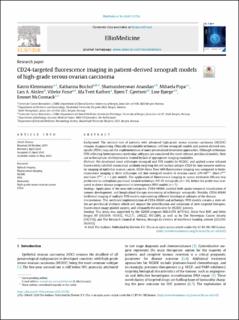CD24-targeted fluorescence imaging in patient-derived xenograft models of high-grade serous ovarian carcinoma
Kleinmanns, Katrin; Bischof, Katharina; Anandan, Shamundeeswari; Popa, Mihaela Lucia; Akslen, Lars A.; Gjertsen, Bjørn Tore; Karlsen, Ida; Fosse, Vibeke Samuelsen; Bjørge, Line; Mc Cormack, Emmet
Journal article, Peer reviewed
Published version

Åpne
Permanent lenke
https://hdl.handle.net/11250/2731669Utgivelsesdato
2020Metadata
Vis full innførselSamlinger
- Department of Clinical Science [2318]
- Registrations from Cristin [9791]
Sammendrag
Background
The survival rate of patients with advanced high-grade serous ovarian carcinoma (HGSOC) remains disappointing. Clinically translatable orthotopic cell line xenograft models and patient-derived xenografts (PDXs) may aid the implementation of more personalised treatment approaches. Although orthotopic PDX reflecting heterogeneous molecular subtypes are considered the most relevant preclinical models, their use in therapeutic development is limited by lack of appropriate imaging modalities.
Methods
We developed novel orthotopic xenograft and PDX models for HGSOC, and applied a near-infrared fluorescently labelled monoclonal antibody targeting the cell surface antigen CD24 for non-invasive molecular imaging of epithelial ovarian cancer. CD24-Alexa Fluor 680 fluorescence imaging was compared to bioluminescence imaging in three orthotopic cell line xenograft models of ovarian cancer (OV-90luc+, Skov-3luc+ and Caov-3luc+, n = 3 per model). The application of fluorescence imaging to assess treatment efficacy was performed in carboplatin-paclitaxel treated orthotopic OV-90 xenografts (n = 10), before the probe was evaluated to detect disease progression in heterogenous PDX models (n = 7).
• View related content for this article
Findings
Application of the near-infrared probe, CD24-AF680, enabled both spatio-temporal visualisation of tumour development, and longitudinal therapy monitoring of orthotopic xenografts. Notably, CD24-AF680 facilitated imaging of multiple PDX models representing different histological subtypes of the disease.
Interpretation
The combined implementation of CD24-AF680 and orthotopic PDX models creates a state-of-the-art preclinical platform which will impact the identification and validation of new targeted therapies, fluorescence image-guided surgery, and ultimately the outcome for HGSOC patients.
Funding
This study was supported by the H2020 program MSCA-ITN [675743], Helse Vest RHF, and Helse Bergen HF [911809, 911852, 912171, 240222, HV1269], as well as by The Norwegian Cancer Society [182735], and The Research Council of Norway through its Centers of excellence funding scheme [223250, 262652].
